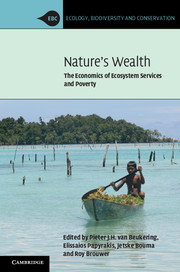Book contents
- Frontmatter
- Contents
- List of contributors
- Acknowledgements
- 1 The economics of ecosystem services and poverty
- Part I Biodiversity-related ecosystem services
- Part II Marine-related ecosystem services
- Part III Forest-related ecosystem services
- Part IV Water-related ecosystem services
- Part V Land-related ecosystem services
- 16 Income poverty and dependence on common resources in rural India
- 17 Tenure security and ecosystem service provisioning in Kenya
- 18 Pastureland degradation and poverty among herders in Mongolia
- 19 Changes in welfare and the environment in rural Uganda
- Index
- References
17 - Tenure security and ecosystem service provisioning in Kenya
Published online by Cambridge University Press: 05 July 2013
- Frontmatter
- Contents
- List of contributors
- Acknowledgements
- 1 The economics of ecosystem services and poverty
- Part I Biodiversity-related ecosystem services
- Part II Marine-related ecosystem services
- Part III Forest-related ecosystem services
- Part IV Water-related ecosystem services
- Part V Land-related ecosystem services
- 16 Income poverty and dependence on common resources in rural India
- 17 Tenure security and ecosystem service provisioning in Kenya
- 18 Pastureland degradation and poverty among herders in Mongolia
- 19 Changes in welfare and the environment in rural Uganda
- Index
- References
Summary
Introduction
Poverty in Kenya is most severe in rural areas where an estimated 65% of the population resides, deriving their livelihood from the natural resource base. About 60% of this rural population was estimated to fall below the poverty line in the year 2000 (Republic of Kenya 2003). One of the most important features of Kenyan agriculture is the large subsistence sector, which makes agriculture even more important for food security. However, over the last three decades, soil erosion and land degradation have become major environmental concerns and present a formidable threat to food security and sustainability of agricultural production.
The proximate causes of land degradation are numerous and militate against the ongoing efforts at poverty alleviation. Efforts at poverty alleviation have failed to bring progress and development despite decades of development assistance. A growing population in combination with poor initial resource endowments, and macro-economic policies biased against agriculture have not only failed to alleviate poverty, but also led to a deterioration of the natural resource base on which rural livelihoods depend. It is generally accepted that development hinges on the dimensions of ecological sustainability, economic feasibility and social acceptance. However, a number of critical dimensions in the development context are unfavourable, yet they constitute the main issues related to sustainable development. These so-called development domain dimensions include agro-ecological potential, population density, market access and institutional setting. Less-favoured areas are typically characterized by a combination of low agricultural potential and/or poor market access; often existing in an institutional setting that is not conducive to alternative viable development pathways (Pender et al. 1999).
- Type
- Chapter
- Information
- Nature's WealthThe Economics of Ecosystem Services and Poverty, pp. 356 - 372Publisher: Cambridge University PressPrint publication year: 2013



